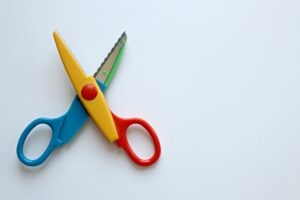Cutting is one of the most complex actions for children. And why that? Because it is a sideways (bilateral) action that requires motor control and accuracy in both hands even though each is doing a different activity. The dominant hand is the one that cuts, and the other hand plays an equally important role – it is called an auxiliary hand. Its role is to stabilize the page, rotate it according to the shear movement, and facilitate the cutting work done by the dominant hand.
Here are 10 essential tips on cutting that will help your child cut
In occupational therapy, there is a constant reference to the person, occupation, and environment. Let’s describe it by order:
- The individual
The recommendations talk about exposure to scissors, cutting, and training the holding of scissors around the age of two and a half to three years. You can expose the child before and play scissor-related games but not expect him to cut (up to age 4 or so). The shear requires perfect control of the muscles of the wrist, fingers, and wrist at a high level that we do not expect from a child who is not ready.
- The occupation
The derivation is a complex operation that requires motor, physical-muscular maturity, and cognitive readiness to understand the task and the solution. I recommend starting with large shapes. To teach a child to cut, you must begin with bristles, drinking straws, and more. In addition, we will start with a completely free cut, we will continue to cut straight lines, and only then will we continue to zigzag and circles (that is considered the most complex shape for cutting).
- The environment
Adjust the size of the scissors to the age and the size of the child’s palm. For small children, use small scissors. When scissors are too large, the hand muscles are busy holding and stabilizing the scissors instead of practicing cutting. Primary scissors are about 3/4 the length of a pen (or pencil), the cutting part (silver) is shorter, and there is a separation between a small hole for the thumb and a big hole for the rest of the fingers (you can purchase at amazon For the remaining three fingers).
- Another tip about the environment
When you start practicing cutting, make sure that the child is sitting comfortably on a chair at a table suitable for him at a height. How do I know? There should be a 90-degree angle in the ankles, knees, and thighs. That the ntire foot of footrests on the floor.
![]()

- Holding the scissors
When you teach the child how to hold the scissors explain to him that the thumb is always up. Meaning the child’s eye should always see the thumb. Children tend to lift the whole hand (from the shoulder) and turn it to cut. We want to teach the child to “save” energy and not embrace the entire hand because otherwise, he will get tired quickly and not finish the activity he started.
- Open and close
If it is difficult to open and close the scissor blades, we can give him dough and plasticine materials with a higher resistance level. Thus, it strengthens the fingers, wrist, and wrist muscles.
- Start cutting
When the child is right-handed, for that matter, I will always ask him to start cutting from the right side to the left side so that the page does not interfere with him during the cutting. In addition, this will make it easier for him to control the scissors and the page.
- Energy over time
cutting is not a simple function and can be tiring over time, so we want to exercise as little muscle as possible to conserve energy. Only the fingers and wrist muscles should act when we cut with scissors. The child will also activate the elbow and sometimes the shoulder to stabilize the hand in the initial cut. Still, over time, we must eradicate this behavior and remain only with the fingers and wrist.
- Hand movement
During the cutting, I recommend teaching the child that only the extra hand (in the case of a right-handed child, this will be the left hand) moves and adapts itself to the movement and position of the hand that cats.

The scissors stay in place. When we cut, only the extra hand moves and moves the page according to the movement of the scissors.
- Page remains
When the child cuts and leaves of a leaf begin to create, help him and cut them. Most of the time, It will disturb the child. When the child grows up, he will do it alone (without tearing the part he needs).
Pleasant cutting 😊



